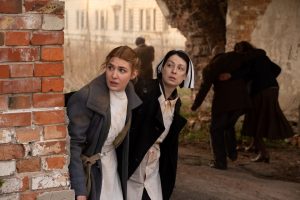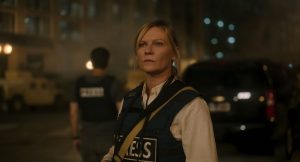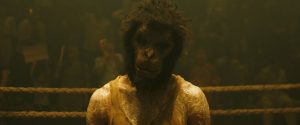Reviews include Irena’s Vow, The Beast, and Before I Change My Mind.
An Interview with Kazik Radwanski on Anne at 13,000 ft. and the ‘False Promise of Intimacy’
February 16, 2021
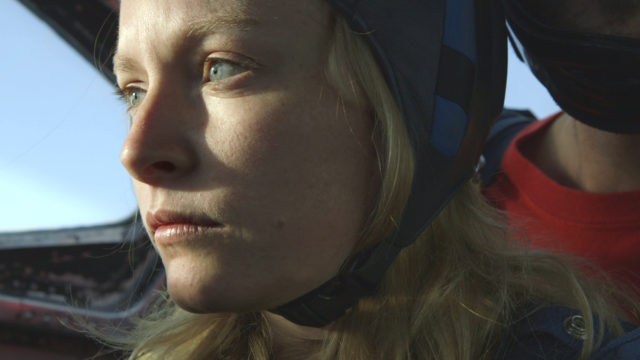
By José Teodoro
When we first meet Anne (Deragh Campbell) she’s making friends with a butterfly: a rare creature at once delicate and capricious enough to earn our skittish heroine’s stillness and attention. The opening moments of Anne at 13,000 ft. draw us in by alternating between Anne’s earthbound encounter with this lovely lepidopteran and an inaugural skydiving jaunt that will prove a transformative, liberating experience for her, one in which all of life’s oppressive expectations are, for a time, spectacularly distant and literally below her.
Echoing the formal strategies of his previous features, Tower (2012) and How Heavy This Hammer (2015), the latest character study from Toronto writer-director Kazik Radwanski conveys narrative predominantly though the study of faces and extremities: whether the setting is a stiff staff meeting at the daycare where Anne works, a wedding reception where Anne’s maid-of-honour speech rambles just a little too long, or a spell of midair reverie, Radwanski, working with cinematographer Nikolay Michaylov, eschews the easing-in orientation of wide or even medium shots in favour tight close-ups, a means of generating a captivating, uneasy energy, as though the camera is an extension of the characters’ nervous systems.
The actors in Anne at 13,000 ft. seem more acutely attuned to Radwanski’s modus operandi than those who populated his earlier works. The film belongs to Campbell—who crafts a compelling, finely graded trajectory for Anne, an inveterate outsider who struggles with what she registers as ubiquitous pressure to conform to stifling social codes and attempts to fight off discomfort by making others uncomfortable—but it also features Matt Johnson as Anne’s suitor and half-willing accomplice in mischief, spending much of his screen-time pivoting between fascination and terror. (I would be remiss were I not to note that Campbell and Johnson are both recipients of the TFCA’s Stella Artois Jay Scott Prize.) Many have noted Anne’s debt to John Cassavetes’ canonical A Woman Under the Influence, but the scenes of Anne and Matt’s courting feel closer to Cassavetes’ ingeniously loopy rom-com Minnie and Moskowitz. Radwanski’s primary fealty is to character, rather than story, style, theme or genre, and there’s something both humble and swaggering about his determination to follow his heroine wherever she may lead him.
Following its debut at the 2019 Toronto International Film Festival, where it competed in the prestigious Platform competition and earned an honourable mention, Anne at 13,000 ft. enjoyed a triumphant festival run, with stops in Vancouver, Montreal and Berlin. More recently, it became one of three films nominated for the TFCA’s Rogers Best Canadian Film Award. (The TFCA virtual gala will stream live on YouTube on March 9, 2021 at 8 p.m.) Anne was to open theatrically in Canada nearly a year ago, before the pandemic thwarted its release, along with most everything else. The film is finally opening virtually this Friday via TIFF Bell Lightbox. I spoke with Radwanski back in September 2019 on the eve of the film’s world premiere.
I know that with your previous features you avoided showing the screenplay to your actors. Was that also the case with Anne?
No, it was different with Deragh. With Derek [Bogart] and Erwin [Van Cotthem] and other actors I’ve worked with, I was always afraid to show them the script, afraid that as soon as we had a few bad takes, things would get tangled up in such a way that I couldn’t save the scene. What I did in the past was workshop a scene and then, once we’d done a few takes, I’d start feeding them lines, get my dialogue into it, mixed amidst the improvisation. In How Heavy This Hammer, there are lines that really stick out, like “I’m an old man, I’m tired,” lines that I really wanted thematically. It was totally different with Anne. Deragh was a close collaborator. I showed her the script really early, about a year before we shot. We strayed from the script quite a bit, incorporating new dialogue, but most of the conflicts and key scenes remain.
When you weren’t showing your actors the script, was this also because you wanted to withhold plot details?
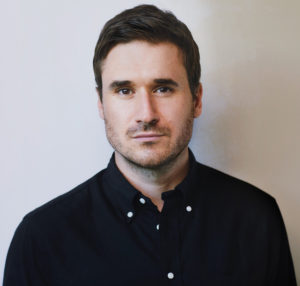
Sure. A little bit. I didn’t want them to get too deep inside the head of the script. Certain actors are so eager to please the director that they overthink it. All three features involved a long process, shooting sporadically over one to two years. There’s a core idea, a core structure, and then a lot of time is spent shooting, thinking about it, shooting more, thinking about it more. With the first two features, as well as a lot of my other work, that process is largely about me figuring out the person I’m working with. What do they do best? What’s interesting about them? With Deragh, who is obviously more experienced, it was much more about trusting her instincts. Sometimes she would bring something braver or bigger or more substantial to a scene than I’d anticipated, so I would just try to follow her lead.
With all three features did you, from the very start, write for the actor you wound up casting?
No. When I wrote Tower, the character was meant to be much more like a typical construction worker, someone who really looked like they worked with their hands. But then we met Derek and he was just so interesting, so this whole idea of nepotism and him being out of place on the construction site emerged with the casting. He was actually living with his parents, so that element, along with how introspective he was or how he loved to pontificate or rant, lined up with the script as originally conceived. With Hammer, I didn’t want to compromise with the physicality. I wanted this big guy that would dominate, that would be sweating over the camera, yelling at these kids. But it was hard to find an actor with that body type, especially one willing to work on a project like this. Then I met Erwin, who is Belgian, and I didn’t imagine the character being Belgian. My dad is British. Somehow I had it in my head that they don’t play rugby in Belgium. I thought about it for a month before coming back to him. Who knows? People have complicated lives. Maybe he went to British boarding school.
They don’t play rugby in Belgium?
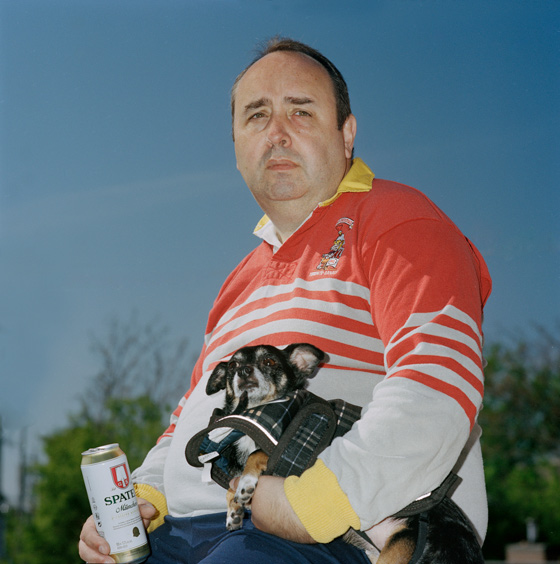
Maybe they do! In any case, it ended up being the key to the film. It was important that he had an immigrant experience, that he didn’t grow up here. Even just the way he would talk to his kids, with the accent, the sternness, would make he think of my Polish grandfather. You can see that he doesn’t quite fit with social norms here. Anyway, in both of those cases, it was a matter going from a very hypothetical place to one where I had to rethink the character for the actor I’d cast. With Deragh it was different. We’d been talking about working together since we met back in 2013. She has a cameo in Hammer as a daycare teacher. That was a test-run for this film.
Do you think of Deragh’s character in Hammer and her character in Anne as being the exact same character?
In a way. There’s a lot of me in these films. A lot of it is very personal, very much from where I grew up. Anne is about a daycare and my mom has run a daycare for the last 40 years. Hammer was about real estate and my dad is a real estate agent. Sometimes I relate heavily with Anne, sometimes heavily with the person she’s interacting with. All three films have something to do with a person who just doesn’t quite fit in to their given situation.
Are you interested in creating a body of work that inhabits a single cosmology, where characters can migrate from one film to another?
I suppose that almost happens with Deragh in Hammer and Anne, but no, I don’t see it as that literal. A lot of this is just the result of things I’ve come to rely on, things that initially arose as practical challenges are now sort of cornerstones of the process. Like locations, for example: all three films have been shot partially in my mother’s house. Tower was in the basement, Hammer in the children’s bedroom on the third floor. We see Deragh break into the house at one point. The dogs are always there. There are, no doubt, lots of real-life elements trickling between the three films. I don’t expect the audience to pick up on that. It being a Toronto film and reflecting on how I grew up in Toronto—that’s important to me. Finding my voice as a filmmaker was dependent on learning to use what was around me. In the case of Anne, a lot of why that film was shot over a two-year period had to do with shooting at a daycare and permission forms and collaborating with daycare teachers. A lot of the actors playing teachers at the daycare are the actual teachers at that daycare. Some of them actually looked after me when I was a child. That was part of the initial inspiration, me being a child at the daycare and then coming back decades later to see the same faces there, reconciling my childhood memory of them with my encounter with them as adults. My mother is also in the film. She plays the supervisor.
What was the seed idea for Anne?
I suppose I just saw a protagonist who could be a teacher at this daycare, that I could explore her personal life there. The daycare setting supplied us with a fruitful microcosm of society, with the presence of other people’s children raising the stakes. I’ve worked with children a lot. I’ve always liked it. Putting Deragh in a room with 30 kids seemed like a good idea. A lot of what brought the film about was Deragh. I was writing it for Deragh, melding what she brings with my experiences.
For me, it’s crucial that the film gets so close to its central character, invests so much in apprehending her experience of the world, but never attempts to pin some particular diagnosis on her or explain her.
Absolutely. And yet another thing that made this film different from my previous films was that we had a backstory. The idea was that she’d had a nervous breakdown in university and that created this uneasy relationship with her mother, so when we begin the film she’s trying to break out on her own again and live more independently. But Deragh and I had, I think, put too much backstory into it and we kept getting stuck. Part of the reason I chose sites like the daycare was so we could just let the character exist in such spaces, learn from the character.
You spoke earlier about Derek’s innate introspection. I feel like Anne is, by contrast, doing anything she can to avoid introspection. The inside of her mind seems like a problematic place for her, so the idea of jumping out of an airplane, an activity that, I have to imagine, erases all other concerns from your mind while you’re doing it, seems to soothe her. She gets to lose herself. And what point did skydiving come into your conception for the film?
Very early. It was in the first draft I gave to Deragh.
Have you done it?
I did it for the film, but never before. I guess I got the idea from hearing stories of people doing that at an older age as a sort of retirement activity. I then realized how accessible it is. It was very affordable to shoot. Some people think this must be my most ambitious film, production-wise, but the whole skydiving deal cost around $600. And GoPros really help to bring the expenses down. We went back to get pickups and it would only cost around $60 a jump. The first scene we shot was Deragh jumping out of the plane. We really wanted to shoot that first, to literally dive right in. Then Nikolay and I were looking at the footage and thought this could be better, but we didn’t have the heart to ask Deragh to jump again without knowing it would yield great footage. I jumped out of the plane and we did a camera test on me and then showed that footage to Deragh, and then she jumped again.
Did your first-hand experience of skydiving affect your sense of the essential meaning of that act?
No. I was able to completely check out while doing it. I was occupied with the camerawork. I remember floating in midair and asking Nikolay, “Can you move the camera this way?” He was, like, “This is your first time skydiving—enjoy it!”
You did the opposite of Anne.
[Laughs] It’s true. The second time she jumped, we shot the scene where she faints. I guess Deragh got more comfortable, too. She did four takes of that in midair.
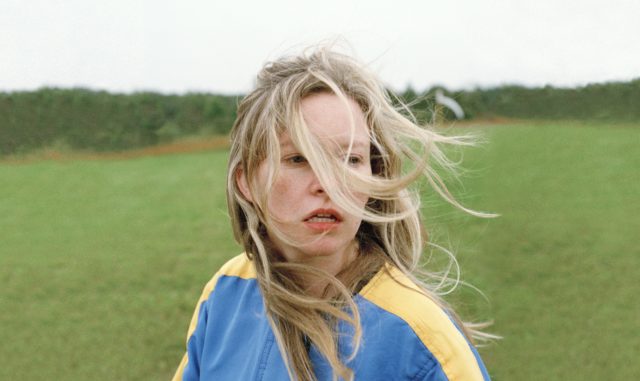
Your films explore a tension between a socially agreed-upon work ethic and personal integrity. Anne is highly engaged with the kids in her charge, but the way she engages is at odds with the job detail. Does this motif reflect questions that you have regarding work, what it means for an individual to be defined by their job, to be at odds with how the world at large has determined what their job is?
Work is something I come back to a lot. Most obviously in Scaffold. It’s even in the name of our company: Medium Density Fibreboard Films. That was inspired by my dad’s side of the family, that worked in construction. I also worked in construction for years. With the daycare in Anne, I view it as similar to Hammer, where you see the character has a love for the kids but their interaction doesn’t fit with society’s norms. It’s a question of an individual being socialized properly. There’s a generational thing there, too, between Anne and the rest of the daycare staff [who are older]. What you’re saying about work ethic versus personal integrity, I hadn’t really considered it quite like that before, but I think you’re right.
By having your own company, by adhering to a particular filmic grammar, by looking for opportunities to have your films exhibited in a meaningful way—reaching their rightful audience, as opposed to just getting them out there any way you can—you seem to embody a conflict between what a film worker is supposed to do, as determined by the industry, and what you as a film worker believes is important.
Yeah. That’s in my films and it’s in me, but in a broader sense it also goes along with the bigger idea of certain people just having a hard time fitting in. Or finding their place. All the films are about that.
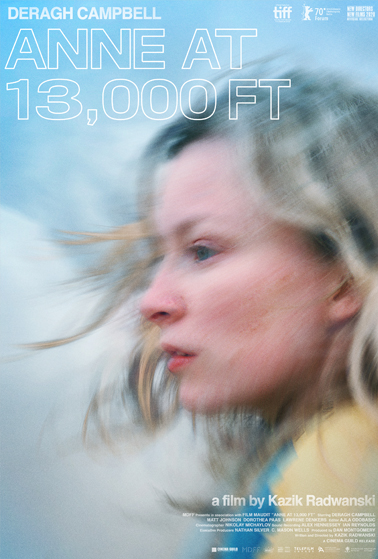 Many scenes in Anne are very short, starting in media res and ending abruptly, lasting just long enough to give an impression. I wonder to what degree editing is key to your storytelling.
Many scenes in Anne are very short, starting in media res and ending abruptly, lasting just long enough to give an impression. I wonder to what degree editing is key to your storytelling.
To a huge degree. I’ve been working with the same editor, Ajla Odobašić, since my first short. Ajla and [producer] Dan [Montgomery] and I went to school together and worked on everything together since 2007. With Anne, the runtime just kept getting shorter the more we worked on it. We did a lot of shuffling around, losing entire sequences. The opening, for example, was something we landed on only in the editing. I’ve always been about economy and not overstaying your welcome, getting a grasp on things through juxtaposition: I’ve always liked the feeling of entering a scene without quite knowing what’s going on and then leaving abruptly if we need to get ourselves somewhere else. Ajla is a great filmmaker. She’s doing her master’s right now at York. She works more in collage, in sculpting. Of course, I’m always shooting in close-up so I know all the while that there’s only so much coverage.
Did you always possess a clear sense of what sort of film grammar you wanted to focus on?
Yeah. All the work shares this aesthetic of close-ups and the writing looks almost pre-edited, in that the scripts will often have jump-cuts already built in. I didn’t know how to articulate that on paper: stacking, jump-cutting, writing enough to create fragments, people talking off-camera.
Do these choices come with a certain meaning or ideology?
On a very simple level, I’m motivated by this sort of realism or intimacy or documentary-like texture. But it starts to become a moral thing. Why are we so close to this person? What do we actually know about this person? There’s an intention to make it not entirely comfortable for the audience to watch, to complicate empathy.
There’s a false promise of intimacy, I think. The movies teach us to interpret a close-up as a moment of psychological or emotional access, seeing things that only the camera can grant us, but your films defy this. Especially Anne. Part of what maintains tension in the film is that fact that we can’t really know her—and that unknowability is heightened by the film’s suspended ending.
Exactly. There’s something I really like about being so close to someone who nonetheless remains mysterious to us. Being almost overwhelmed, being so close and not being able to keep up. That inscrutability is fascinating—the false promise of intimacy, as you call it—and the anti-climax is also part of it. For me this feels true. These films are little operas, but they don’t close with a big climax. Instead, they capture a span of time that will come to define the character’s life, build up to a turning point, and leave us there, adrift.
Anne at 13,000 ft. streams via TIFF Bell Lightbox beginning Feb. 19.

